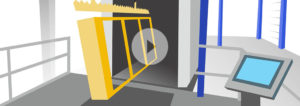Kevin Howe, IntelliFinishing Project Manager
Kevin just finished the setup on IntelliFinishing’s latest project installation. During the construction process he took us on a brief tour. It was an active construction site so the system wasn’t running yet. View the tour video >>
The IntelliFinishing system starts with a lift, which is basically an elevator-style, drop section. The orange pieces of the conveyor will come down to a lower height making it more ergonomic for connecting the parts to the carrier. Then it will rise back up after the part information is loaded and send the carrier into the system.
The control stations will have a touch screen monitor that will display different part information.
The uninstalled load bars are the mechanical pieces that support picture frame style hangers that will in turn support the customer parts. The metal trolleys are the load trolleys that support the weight of the entire piece. The rubber wheels on the top contact our spinning tube and provide the propulsion for the conveyer system. It is a friction setup with a spring tension pressing against the tube. The IntelliFinishing system is unique as it goes forward and reverse directions. This typical configuration is capable of supporting 3,000 pounds, including the weight of the load bar.
From the elevator-style lift section we proceed downstream towards a manual wash booth area. In this instance, we’re interfacing to a customer provided wash booth. We are going to control the doors that will slide open and closed pneumatically. Internally the wash booth will be similar to a manual car wash bay. The operator will select a cleaner rinse, a phosphate rinse and a sealer to keep the parts from flash rusting.
From the wash bay we head to the small drip zone. Currently this is a manual pull through section, which the customer requested for Phase 1. In Phase 2 we will add an automated wash parallel to this section. At that time most of the parts will go through the automated wash so in the future, less volume will run on the pull through section.
Parts will then be pulled to the first motorized section after the wash booth to air blow off. The air blow off is also similar to a car wash system with nozzles and large, electrically powered air blowers. The nozzles will be directed at the parts to dry off any of the residual water.
After the blow off area is a dry off oven. This oven is a little smaller, holding one carrier at a time. The oven is used to help boil off any leftover residual water that was not taken care of in the air blow off stage. It also helps to preheat the part, getting it ready prior to powder coating.
We head out of the dry off oven and around the corner to the powder coat booth. This is a manually applied powder station at this time. They will have several operators, one on each side, applying the powder coat to the parts. Monitors will also let the operators know what color they are supposed to be painting and what is coming up next.
The last station is the cure oven. This is a 450° powder oven. It has 3 motor stations and will be able to hold 3-4 carriers worth of parts at a time. When the units are finished curing, they come out to a several storage areas to give them time to cool.
Since our system is an oval it then brings us back to the beginning. This is the backside of the lift elevator section we saw at the start.
Related posts
Search this blog
Get email updates
Archives
- May 2024
- April 2024
- August 2023
- May 2023
- April 2023
- March 2023
- June 2022
- May 2022
- April 2022
- November 2021
- October 2021
- September 2021
- April 2021
- March 2021
- January 2021
- October 2020
- August 2020
- June 2020
- May 2020
- February 2020
- January 2020
- December 2019
- October 2019
- September 2019
- June 2019
- May 2019
- March 2019
- February 2019
- October 2018
- September 2018
- August 2018
- July 2018
- June 2018
- May 2018
- April 2018
- March 2018
- July 2017
- June 2017
- May 2017
- April 2017
- March 2017
- February 2017
- December 2016
- June 2016
- May 2016
- April 2016
- February 2016
- January 2016
- September 2015
- June 2015
- March 2015
- February 2015
- January 2015
- December 2014
- November 2014
- August 2014
- June 2014
- May 2014
- April 2014
- August 2013
- July 2013
- March 2013
- October 2012
- September 2012
- March 2011
- February 2011
- January 2011
- October 2010



